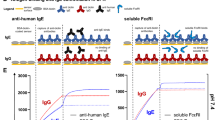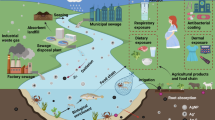Abstract
We investigated the mechanism of transplacental macromolecular transport in rats on the nineteenth day of pregnancy using tracers, transmission electron microscopy and immunohistochemistry. The blood-placental barrier of full-term rat placentas was composed of a trilaminar layer of trophoblast cells that separates the fetal capillaries from the maternal blood spaces: a layer of cytotrophoblasts lining the maternal blood space and a bilayer of syncytiotrophoblast surrounding the fetal capillaries. Horseradish peroxidase, intravenously injected into the maternal circulation, was found in the maternal blood spaces, the interspaces between the cytotrophoblasts and the syncytiotrophoblast I, many pits and small vesicles in the syncytiotrophoblast I, vesicles of the syncytiotrophoblast II, fetal connective tissue and fetal capillaries. Intravenously injected ovalbumin was detected in the maternal blood spaces, a trilaminar layer and the fetal capillaries. Neonatal Fc receptor (FcRn), a receptor for IgG, was localized at the maternal side of the blood-placental barrier. These results show that the structure of the rat blood-placental barrier is quite similar to the human blood-placental barrier, and non-specific macromolecules and food allergens may penetrate through the blood-placental barrier of the full-term placenta from the maternal to fetal circulation mediated by FcRn.





Similar content being viewed by others
References
Chan-Yeung M, Ferguson A, Chan H, Dimich-Ware H, Watson W, Manfreda J, Becker A (1999) Umbilical cord blood mononuclear cell proliferative response to house dust mite does not predict the development of allergic rhinitis and asthma. J Allergy Clin Immunol 104:317–321
Marks GB, Zhou J, Yang HS, Joshi PA, Bishop GA, Britton WJ (2002) Cord blood mononuclear cell cytokine responses in relation to maternal house dust mite allergen exposure. Clin Exp Allergy 32:355–360
Smillie FI, Elderfield AJ, Patel F, Cain G, Tavenier G, Brutsche M, Craven M, Custovic A, Woodcock K (2001) Lymphoproliferative responses in cord blood and at one year: no evidence for the effect of in utero exposure to dust mite allergens. Clin Exp Allergy 31:1194–1204
Vance GH, Lewis SA, Grimshaw KE, Wood PJ, Briggs RA, Thornton CA, Warner JO (2005) Exposure of the fetus and infant to hens’ egg ovalbumin via the placenta and breast milk in relation to maternal intake of dietary egg. Clin Exp Allergy 35:1318–1326
Edelbauer M, Loibichler C, Witt A, Gerstmayr M, Putschögl B, Urbanek R, Szépfalusi Z (2003) Dose-dependent and preterm-accentuated diaplacental transport of nutritive allergens in vitro. Int Arch Allergy Immunol 130:25–32
Szépfalusi Z, Loibichler C, Hänel-Dekan S, Dehlink E, Gerstmayr M, Pichler J, Eiwegger T, Horvat R, Urbanek R (2006) Most of diaplacentally transferred allergen is retained in the placenta. Clin Exp Allergy 36:1130–1137
Edwards D, Jones CJ, Sibley CP, Nelson DM (1993) Paracellular permeability pathways in the human placenta: a quantitative and morphological study of maternal–fetal transfer of horseradish peroxidase. Placenta 14:63–73
Brownbill P, Edwards D, Jones C, Mahendran D, Owen D, Sibley C, Johnson R, Swanson P, Nelson DM (1995) Mechanisms of alphafetoprotein transfer in the perfused human placental cotyledon from uncomplicated pregnancy. J Clin Invest 96:2220–2226
Nishikawa M, Iwano H, Yanagisawa R, Koike N, Inoue H, Yokota H (2010) Placental transfer of conjugated bisphenol A and subsequent reactivation in the rat fetus. Environ Health Perspect 118:1196–1203
Roopenian DC, Akilesh S (2007) FcRn: the neonatal Fc receptor comes of age. Nat Rev Immunol 7:715–725
Leach JL, Sedmak DD, Osborne JM, Rahill B, Lairmore MD, Andeeson CL (1996) Isolation from human placenta of the IgG transporter, FcRn, and localization to the syncytiotrophoblast: implications for maternal–fetal antibody transport. J Immunol 157:3317–3322
Rath T, Kuo TT, Baker K, Qiao SW, Kobayashi K, Yoshida M, Roopenian D, Fiebiger E, Lencer WI, Blumberg RS (2012) The immunologic functions of neonatal Fc receptor for IgG. J Clin Immunol [Epub ahead of print]
Simister NE (2003) Placental transport of immunoglobulin G. Vaccine 28:3365–3369
Kristoffersen EK, Matre R (1996) Co-localization of the neonatal Fc gamma receptor and IgG in human placental term syncytiotrophoblasts. Eur J Immunol 26:1668–1671
Nakata K, Kobayashi K, Ishikawa Y, Yamamoto M, Funada Y, Kotani Y, Blumberg RS, Karasuyama H, Yoshida M, Nishimura Y (2010) The transfer of maternal antigen-specific IgG regulates the development of allergic airway inflammation early in life in an FcRn-dependent manner. Biochem Biophys Res Commun 395:238–243
Watson ED, Cross JC (2005) Development of structures and transport functions in the mouse placenta. Physiology (Bethesda) 20:180–193
Maltepe E, Bakardjiev AI, Fisher SJ (2010) The placenta: transcriptional, epigenetic, and physiological integration during development. J Clin Invest 120:1016–1025
El-Hashash AH, Warburton D, Kimber SJ (2010) Genes and signals regulating murine trophoblast cell development. Mech Dev 127(1–2):1–20
Adamson SL, Lu Y, Whiteley KJ, Holmyard D, Hemberger M, Pfarrer C, Cross JC (2002) Interactions between trophoblast cells and the maternal and fetal circulation in the mouse placenta. Dev Biol 250:358–373
Ain R, Canham LN, Soares MJ (2003) Gestation stage-dependent intrauterine trophoblast cell invasion in the rat and mouse: novel endocrine phenotype and regulation. Dev Biol 260:176–190
Coan PM, Conroy N, Burton GJ, Ferguson-Smith AC (2006) Origin and characteristics of glycogen cells in the developing murine placenta. Dev Dyn 235:3280–3294
Pijnenborg R, Vercruysse L (2010) Animal models of deep trophoblast invasion. In: Pijinenborg R, Brosens I, Romero R (eds) Placental bed disorders. Cambridge University Press, Cambridge, pp 127–139
Jacob HJ, Lazer J, Dwinell MR, Moreno C, Geurts AM (2010) Gene targeting in the rat: advantages and opportunities. Trends Genet 26:510–518
Furukawa S, Hayashi S, Usuda K, Abe M, Hagio S, Ogawa I (2011) Toxicological pathology in the rat placenta. J Toxicol Pathol 24:95–111
Soares MJ, Chakraborty D, Karim Rumi MA, Konno T, Renaud SJ (2012) Rat placentation: An experimental model for investigating the hemochorial maternal–fetal interface. Placenta 33:233–243
Jacob HJ, Kwirwk AE (2002) Rat genetics: attaching physiology and pharmacology to the genome. Nat Rev Genet 3:33–42
Shin BC, Fujikura K, Suzuki T, Tanaka S, Takata K (1997) Glucose transporter GLUT3 in the rat placental barrier: a possible machinery for the transplacental transfer of glucose. Endocrinology 138:3997–4004
Metz J, Aoki A, Forssmann WG (1978) Studies on the ultrastructure and permeability of the hemotrichorial placenta. I. Intercellular junctions of layer I and tracer administration into the maternal compartment. Cell Tissue Res 192:391–407
Aoki A, Metz J, Forssmann WG (1978) Studies on the ultrastructure and permeability of the hemotrichorial placenta. II. Fetal capillaries and tracer administration into the fetal blood circulation. Cell Tissue Res 192:409–422
Kawahata K, Takahashi J, Yasuda Y, Tanimura I (1990) Studies on the ultrastructure and polystyrene particle permeability of trophoblastic layers in the rat placenta. Jpn J Zootech Sci 61:433–437
Hu D, Cross JC (2010) Development and function of trophoblast giant cells in the rodent placenta. Int J Dev Biol 54:341–354
Van der Aa EM, Peereboom-Stegeman JH, Noordhoek J, Gribnau FW, Russel FG (1998) Mechanisms of drug transfer across the human placenta. Pharm World Sci 20:139–148
Takizawa T, Anderson CL, Robinson JM (2005) A novel Fc gamma R-defined, IgG-containing organelle in placental endothelium. J Immunol 175:2331–2339
Israel EJ, Patel VK, Taylor SF, Marshak-Rothstein A, Simister NE (1995) Requirement for a beta 2-microglobulin-associated Fc receptor for acquisition of maternal IgG by fetal and neonatal mice. J Immunol 154:6246–6251
Hatae T, Fujita M, Sagara H (1986) Helical structure in the apical tubules of several absorbing epithelia. Kidney proximal tubule, visceral yolk sac and ductuli efferentes. Cell Tissue Res 244:39–46
Kim J, Mohanty S, Ganesan LP, Hua K, Jarjoura D, Hayton WL, Robinson JM, Anderson CL (2009) FcRn in the yolk sac endoderm of mouse is required for IgG transport to fetus. J Immunol 182:2583–2589
Catunda Lemos AP, Cervenak J, Bender B, Hoffmann OI, Baranyi M, Kerekes A, Farkas A, Bosze Z, Hiripi L, Kacskovics I (2012) Characterization of the rabbit neonatal Fc receptor (FcRn) and analyzing the immunophenotype of the transgenic rabbits that overexpresses FcRn. PLoS One 7:e28869
Kumagai N, Baba R, Sakuma Y, Arita K, Shinohara M, Kourogi M, Fujimoto S, Fujita M (2011) Origin of the apical transcytic membrane system in jejunal absorptive cells of neonates. Med Mol Morphol 44:71–78
Acknowledgments
We thank Dr. Nana Kumagai for her skillful technical assistance. This study was supported in part by a Grant-in-Aid for Scientific Research (KAKENHI) from the Ministry of Education, Science, Sports, and Culture of Japan (RB, HM and MF).
Author information
Authors and Affiliations
Corresponding author
Rights and permissions
About this article
Cite this article
Sakuma, Y., Baba, R., Arita, K. et al. Food allergens are transferred intact across the rat blood-placental barrier in vivo. Med Mol Morphol 47, 14–20 (2014). https://doi.org/10.1007/s00795-013-0029-9
Received:
Accepted:
Published:
Issue Date:
DOI: https://doi.org/10.1007/s00795-013-0029-9




